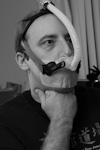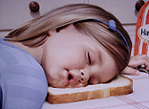If you read my previous thread, you saw I had a sleep study with the Winx system by Apnicure. My one-week trial machine arrived tonight, so I thought I'd give a quick overview and photos of it, because it's totally different from a xPAP machine.
The basic machine:

Here's the complete setup:

xPAP is a positive pressure device, air-splinting the airway by blowing air into you. The winx works the opposite, by creating a vacuum in the mouth, which pulls the tongue forward. There's a couple of important facts which I've concluded as purely a user of xPAP when possibly evaluating Winx:
1) It can only address obstructions due to the tongue falling backwards into the throat, and maybe the soft palette. It doesn't address central type apneas at all.
2) Because it pulls the tongue forward, you breathe normal air pressure through the nose. You can't breathe through your mouth.
3) Because it doesn't hold a pressure with your breathing, it can't detect obstructions or when you stop breathing. So, basically, no data.
4) It "sucks" from your mouth, so I figured it will suck out drool over night. It does. If you create a lot of saliva, it might not work.
So, I think it's an interesting therapy, very different than CPAP. Due to my problems with CPAP (NOT a problem in simply using it - it just doesn't work all the way for me for whatever reason. My AHI is 0 most nights!)

You can see how big it is compared to a resmed S9 vpap adapt. It looks like it will travel very easily. Same requirements for needing power as CPAP - not sure how it would work on battery if you were that type. The only buttons are the top "release" button for the saliva tank, and the start/stop button. These early models don't have any type of end-user data. I imagine it could eventually collect some data on how well the vacuum is maintained.
During the sleep study, the device had to be set on a folded towel to mute the noise a bit. It's very quiet, except for the vibration. About the same as a quiet CPAP I think. I'll be able to tell more tonight when I use it.

This is the mouthpiece you wear. There's two pipes leading from it. One is supposed to suck air away to create the vacuum, the other sucks saliva. Or so I was told.
In my experience, it sucks itself to the top of your mouth, and then the tongue follows it. The vacuum is a bit weird, but not uncomfortable. Certainly, not worse than CPAP was the first night by a mile. I have worn a dental appliance, so that might make it easier for me. I believe the mouthpiece gets replaced every 3 months if you're a user, and you clean it with plain water.
In my one night with it at the sleep study, I felt like my tongue had gone through a strenuous workout the next day, but it wasn't too bad. I imagine some users will have problems with it, depending on your tongue, and it's certainly strange. Getting the vacuum will be another problem - for me, it was simply trying to swallow. I felt like the lips felt sealed pretty easily and I could release the vacuum easily anytime I wanted.

You can see the saliva tank here, popped out of the winx. There's a cup with a thingy in it, and you screw the top on. You empty it out each night. If it gets full, the top of it detects that it's full and turns the device off. I'm not sure if that creates an alarm sound or not, yet.

close-up of the top of the saliva tank. If this part is wet at all, it will cause the device to turn off.
So, this is all pretty much a shot in the dark for me. I'm hoping it will help, or be better than CPAP. Since there's not really data, I'm going to have to go by how I feel. I have been pretty accurate in how I feel in terms of CPAP data to back me up.
If there's any questions about it, let me know!












